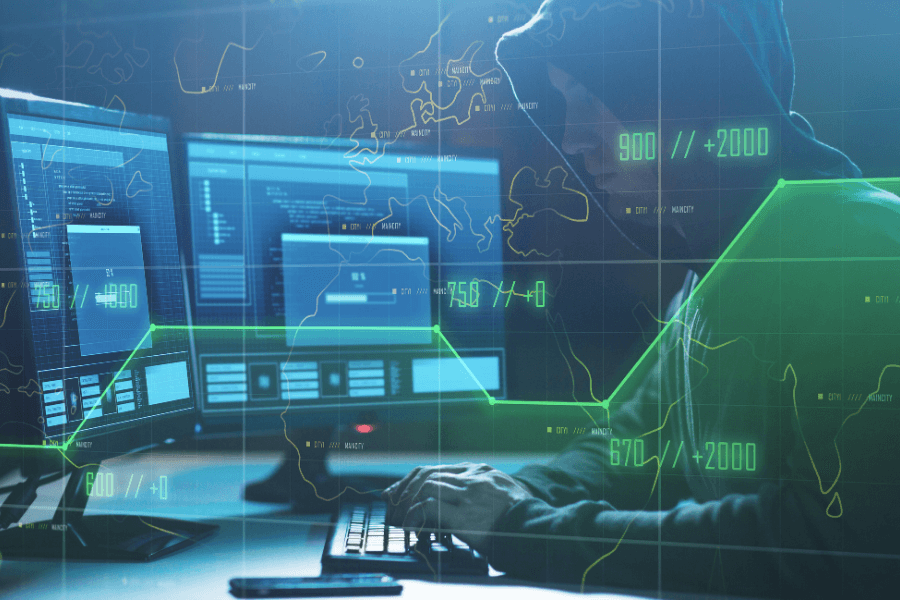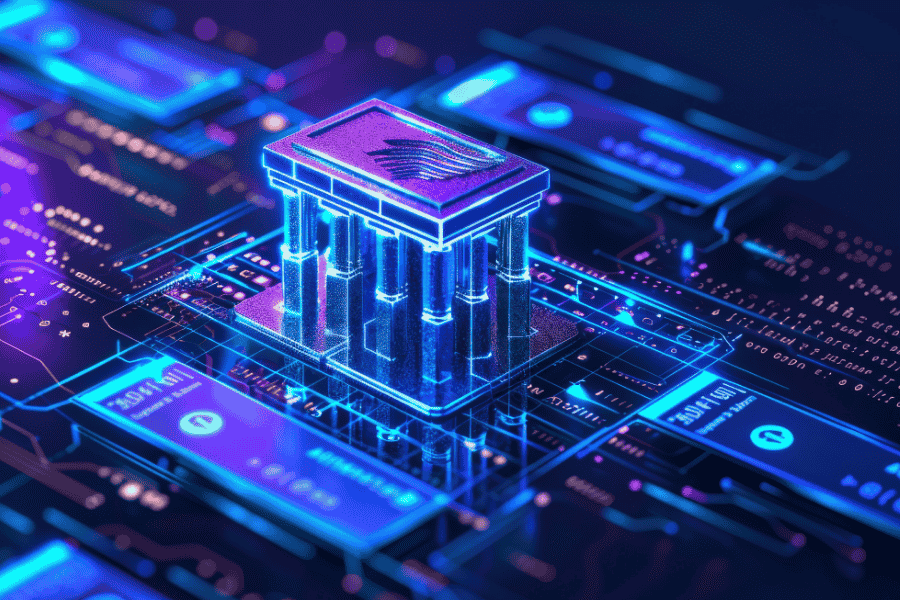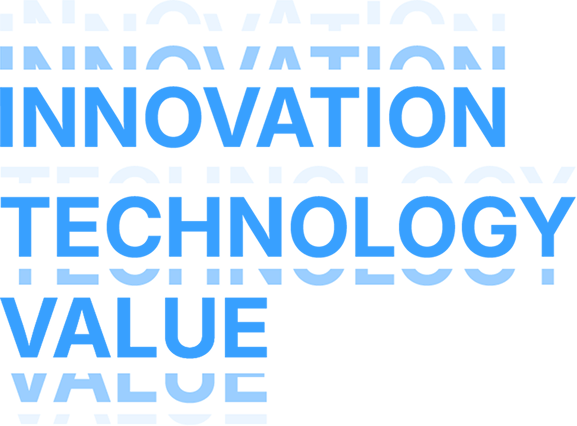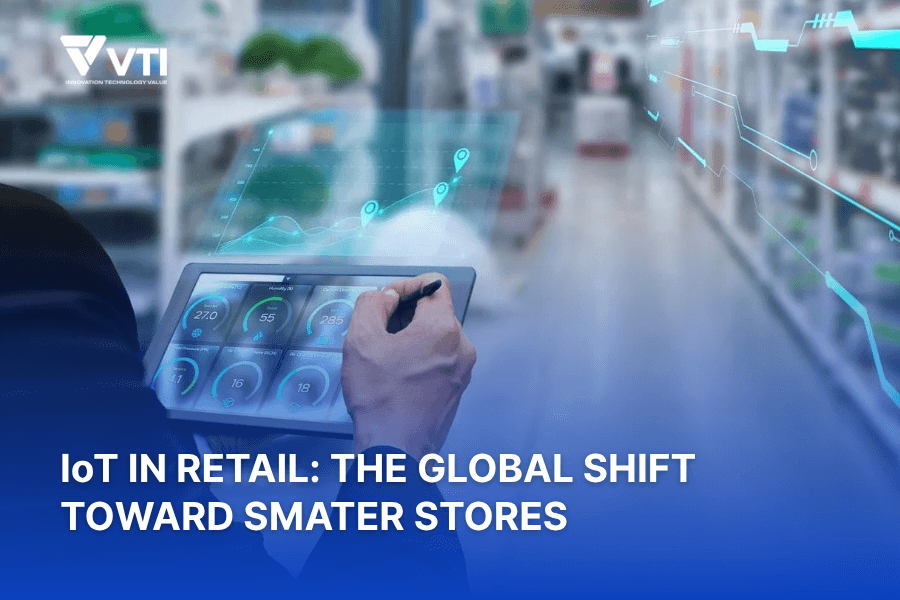
Knowing exactly which products are running low. Offering personalized discounts the moment a customer walks in. Automatically updating inventory in real time as items are sold. These aren’t just dreams of retail managers. They’re now a reality, thanks to IoT in retail.
With the power of connected devices, IoT in retail is revolutionizing how businesses operate within retail stores, transforming traditional, time-consuming processes into streamlined, efficient, data-driven systems. IoT is making once-complex tasks smoother, faster, and more accurate, ultimately creating a more efficient, data-driven, and responsive retail environment.
In this article, we’ll explore how IoT applications are reshaping the retail industry, unlocking new growth opportunities, and why it’s crucial for businesses to get on board. Ready to see the future of retail unfold? Let’s dive in!
Understanding IoT in Retail
What is IoT in retail?
The Internet of Things (IoT) refers to a network of interconnected devices that communicate and exchange data over the Internet. In retail, IoT refers to a growing network of internet-connected devices, ranging from sensors and cameras to smart appliances, that collect, analyze, and exchange data. These tools enable businesses to monitor, manage, and analyze a wide range of operational aspects in real-time.
At its core, IoT in retail stores aims to enhance the shopping experience, optimize operations, and provide valuable insights to businesses. Leveraging IoT solutions helps retailers stay competitive in an ever-changing market.
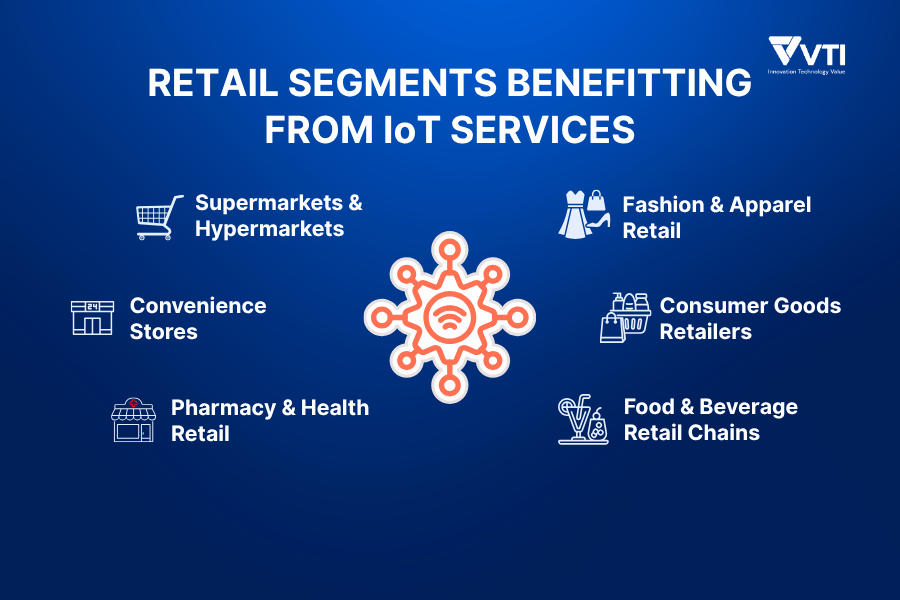
Key Technologies Powered IoT in Retail
With the rise of connected devices, IoT applications in retail are revolutionizing how retailers manage everything from inventory to customer experiences. The core IoT technologies are reshaping the retail landscape, driving smarter, more efficient operations. Below are the key technologies driving the digital revolution in retail.
Sensors and Identification Technologies
RFID
RFID (Radio Frequency Identification) is one of the most impactful technologies in retail today, with a 33.0% share of the Internet of Things in the retail market sector in 2024. By using RFID tags, retailers can track products in real-time, ensuring accurate inventory management. According to GS1 US, RFID can improve inventory accuracy by up to 95% and reduce stockouts by 30%. This leads to fewer instances of out-of-stock products, improving sales and customer satisfaction. RFID helps automate restocking and loss prevention, streamlining processes and improving efficiency.
NFC
NFC (Near Field Communication) is transforming customer payments and in-store interactions. This technology enables contactless payments, allowing customers to make secure transactions with a simple tap of their phone or card. According to a 2024 report, NFC-enabled payments accounted for 43% of all mobile payments in retail, with this figure expected to grow. NFC also powers customer engagement by offering personalized promotions or product information directly to customers’ smartphones with a simple scan.
Connectivity and Data Transmission
Every IoT device needs a strong connection. In retail, Wi-Fi is the backbone that ensures smooth communication between IoT devices in-store, such as smart shelves, POS systems, and inventory trackers. With the increasing reliance on real-time data, Wi-Fi enables continuous updates across devices, helping retailers track everything from customer purchases to stock levels, ensuring seamless operations and enhancing overall customer satisfaction.
Data Processing and Analysis
Cloud Computing
Cloud platforms store and process the massive amounts of data generated by IoT devices. This technology is projected to generate USD 70.3 billion in revenue for the retail industry by 2027 (Gartner). Cloud computing enables retailers to analyze customer behavior, track inventory, and optimize the supply chain in real-time, while also scaling operations without heavy investments in physical infrastructure.
Edge Computing
Edge computing allows data to be processed closer to the source of generation, reducing latency and enabling real-time decision-making. For example, in dynamic pricing and inventory management, edge computing enables instant updates as products are sold or restocked, creating a more responsive and seamless shopping experience for customers.
AI and Machine Learning
AI and machine learning are transforming how retailers engage with customers and manage operations. AI-powered systems can analyze vast amounts of data to personalize customer recommendations, improve inventory forecasting, and automate marketing strategies. By 2027, AI in retail is projected to reach USD 40.5 billion. Machine learning also enables retailers to predict trends and optimize store layouts, ultimately improving sales and operational efficiency.
The IoT Retail Landscape Now
The state of IoT in the retail market
The IoT retail market is rapidly expanding. Projections show it will reach $177.90 billion by 2031, growing at a CAGR of 20.3% from 2022 to 2031. As IoT technologies in retail continue to revolutionize the market, businesses are adopting connected systems to improve inventory management, enhance customer experiences, and streamline operations. By 2030, the economic value of IoT retail environments is expected to range between $5.5 trillion $12.6 trillion (McKinsey), emphasizing the vast potential for innovation in the sector.
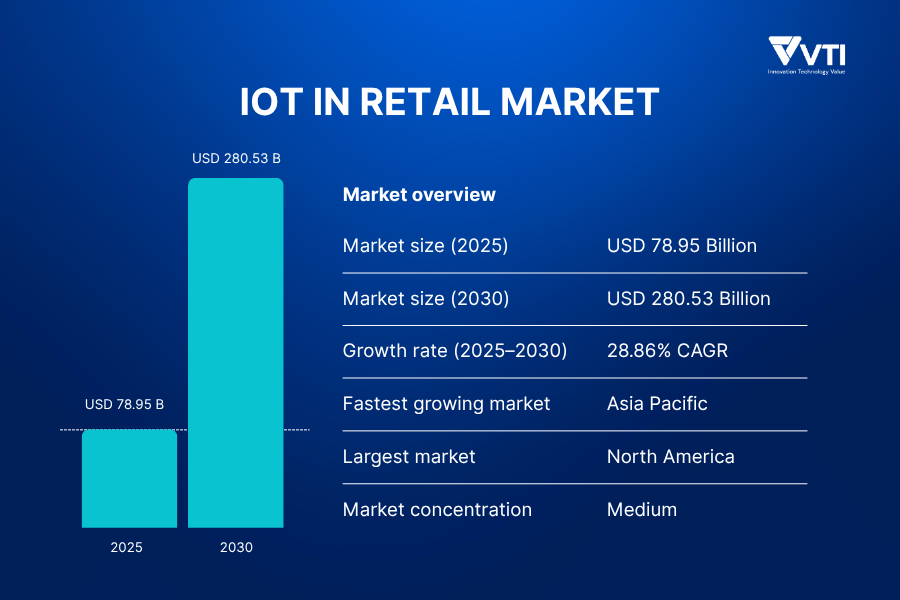
IoT adoption across retail sectors
The retail sector is embracing IoT and retail at varying speeds. Supermarkets and hypermarkets are expected to account for 39.0% of total retail spending in 2024, driven by the need for efficient inventory management and energy-saving technologies, such as smart shelves and RFID systems. Meanwhile, e-commerce warehouses are growing at a 28.90% CAGR, as IoT-enabled automation optimizes pick-pack-ship flows for omnichannel retailers.
Convenience stores are adopting compact IoT vision solutions to reduce shrinkage and ensure security at unmanned kiosks, while department stores are using smart mirrors and AR displays to create personalized shopping experiences.
Key IoT Applications in Retail
The rise of IoT applications in retail is a game-changer. Retailers are leveraging IoT and retail to streamline back-end operations, optimize stock levels, and provide customers with a more personalized experience. Here’s how IoT retail is changing the rules of retail, one innovation at a time.
Smart shelves and automated stock replenishment
The integration of smart shelves into retail IoT environments is one of the most exciting IoT applications in retail. With sensors and RFID tags, these shelves can monitor stock levels in real-time and trigger automated replenishment alerts. This helps maintain optimal stock levels and prevents stockouts.
MUJI, a renowned Japanese retailer, has adopted RFID-powered smart shelves as part of its IoT in retail strategy to enhance inventory accuracy and operational efficiency. As stock levels decrease, the system sends real-time alerts to store managers, prompting automatic restocking. This system has not only streamlined inventory management but also led to a 15% reduction in labor costs associated with manual stock checks.
Optimizing product placement and merchandising
The key to boosting sales and enhancing the shopping experience is optimizing product placement. IoT-powered heat maps provide valuable insights into customer behavior by tracking foot traffic and interactions with products in real time. This helps retailers place high-demand items in the most visible spots, encouraging more sales and improving the overall shopping journey.
7-Eleven Japan uses IoT-powered heat maps to track real-time customer movement. By analyzing this data, 7-Eleven optimizes the placement of popular items like snacks and beverages in high-traffic areas. The system also adjusts displays and promotions based on traffic patterns, maximizing visibility for key products. This approach helps 7-Eleven reduce stockouts, improve sales, and provide a better shopping experience.
Real-time inventory management
IoT in retail is revolutionizing inventory management. With technologies like RFID tags and smart shelves, retailers can track inventory in real time, reducing human error and ensuring that products are consistently available on shelves. This automation not only enhances inventory accuracy but also helps prevent costly stockouts.
According to McKinsey & Company, modern RFID solutions can increase inventory accuracy by over 25%. This accuracy leads to a 1 to 3.5% sales uplift, as fewer stockouts mean more sales opportunities. Additionally, RFID reduces cycle count times by up to 96%, improving labor productivity.
Lawson, one of Japan’s leading convenience store chains, is a great example of this in action. Lawson has integrated RFID-powered smart shelves into its stores, enabling real-time tracking of inventory. As stock levels drop, the system automatically alerts store managers to reorder, ensuring products are always available. This has streamlined inventory management and improved customer satisfaction by minimizing stockouts and ensuring popular products are consistently in stock.
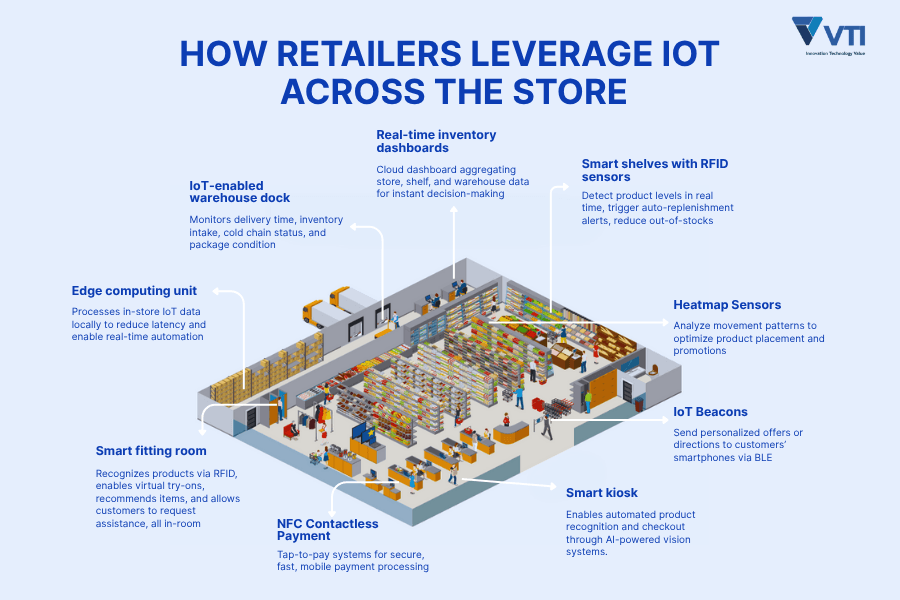
Supply Chain Visibility
IoT solutions in retail are transforming supply chain management, providing enhanced visibility into logistics, inventory, and product conditions. Retailers can reduce supply chain costs by 10-15% and improve operational efficiency by 20% through the use of GPS sensors, temperature monitors, and condition-tracking devices. These technologies ensure that products are delivered on time and in optimal condition, reducing delays and preventing spoilage.
Alibaba is a trailblazer in using IoT to manage its expansive e-commerce logistics network. By integrating smart containers and IoT sensors, Alibaba tracks product location, temperature, and condition in real-time. This technology has allowed Cainiao, Alibaba’s logistics arm, to reduce delivery times by 30% while improving transparency and efficiency throughout the supply chain.
Check out VTI’s IoT in retail case study: In-store Heatmap: A Solution When Customer Traffic Slows Down
Smart Checkout Solutions
43% of consumers now prefer self-checkout over traditional cashier lanes. This trend is fueling the rise of IoT-powered smart checkout solutions, including self-checkout kiosks and scan & go systems. These solutions are particularly popular in Japan, where retailers are embracing the technology. Powered by RFID, computer vision, NFC, and sensor systems, smart checkout solutions enable fast, seamless transactions that boost both operational efficiency and the customer experience.
U.S.M.H., one of the largest retail operators in Asia, has integrated Scan & Go systems across its network of stores. By using computer vision, RFID, and sensor technology, USMH’s Scan & Go system allows customers to simply scan products as they shop, and then pay automatically through their mobile app or account without the need to stand in a checkout line. This innovative system eliminates the traditional checkout process, reducing wait times and improving the overall shopping experience for customers.
Personalized customer experience
Personalized shopping experiences are proven to increase customer loyalty and drive sales, with a 20% boost in customer retention. To achieve this, many leading retailers are leveraging IoT technologies. Through beacons and location-based sensors, retailers can send tailored promotions and product recommendations based on a customer’s behavior and preferences.
For example, Uniqlo has successfully integrated IoT into its stores to enhance the customer experience. By using smart mirrors and RFID technology, Uniqlo allows customers to try on clothes virtually and receive real-time, personalized product recommendations. This not only increases engagement but also provides a high-tech, seamless shopping experience, encouraging repeat visits.
How to Choose the Right IoT Solution for Retail
When it comes to adopting IoT in retail, the options can feel overwhelming. With so many tools and technologies out there, picking the right one can be tricky. But don’t worry – here’s how to break it down and find the perfect fit for your business needs.
Know your needs first
Before you jump into any IoT solution, take a moment to think about what you really need. Are you struggling with stockouts and inventory tracking? Want to improve the shopping experience for your customers? Or maybe you’re looking to streamline your supply chain?
The right IoT solution should solve your specific problems. For example, if inventory management is your priority, then RFID and smart shelves are a great place to start. If improving customer engagement is your goal, look into beacons or smart mirrors that offer personalized recommendations and real-time feedback.
Think about growth
It’s not just about solving today’s issues; you also want a solution that can grow with you. Choose an IoT system that’s flexible and scalable, so you can expand your operations without hitting a wall. Cloud-based solutions are often great for this, as they can scale up easily with your business.
Also, keep in mind that your IoT solution should integrate seamlessly with your existing tech. So, before you commit, check if the system can play nice with your legacy systems, whether it’s your POS or inventory tools.
Integration with what you already have
Retailers often face a huge challenge when integrating new IoT tech with their existing systems. Whether you’re working with outdated POS terminals or old inventory management tools, the key is to select a solution that fits well with what you already use.
Look for vendors that offer open platforms and easy integrations. Many modern IoT systems are built with flexibility in mind, so they can connect with your current operations without making everything feel like it’s starting from scratch.
Weighing costs against the benefits
The upfront cost of IoT might seem steep, but the long-term benefits usually make it worth it. Focus on areas where the return will be the quickest, think automated inventory management, smart checkout systems, and personalized customer experiences. These areas can drive immediate value, from saving on labor costs to improving customer retention.
When calculating ROI, keep both the cost savings and sales growth in mind. Reducing stockouts, increasing product availability, and offering personalized promotions can lead to increased sales and happier customers.
Support and service are key
The right IoT vendor should do more than just sell you a product; they need to support you through the whole process. Look for vendors who offer strong customer support, easy-to-follow training, and continuous maintenance. You need a partner who will be there when you need them.
Also, consider how much experience the vendor has in the retail space. Working with a vendor that has proven success in retail IoT can give you peace of mind, knowing they understand the unique challenges of the industry.
Prioritize security and compliance
Last but certainly not least, make sure your IoT solution is secure. With so much data being collected, retailers need to be sure they’re protecting both customer and business information. Look for vendors that prioritize data encryption, security updates, and compliance with privacy regulations. It’s all about protecting your customers and your brand’s reputation.
Read also: What is Customer Data Platform? Guide To Find Your Best Option
Conclusion
The potential of IoT in retail is immense. From streamlining operations to creating personalized shopping experiences, IoT in retail stores is revolutionizing the industry. By adopting IoT applications in retail, businesses can stay competitive, improve efficiency, and enhance customer satisfaction.
At VTI, we specialize in retail IoT solutions that help businesses implement innovative technologies. Whether you’re looking to optimize inventory management, improve customer engagement, or integrate smart systems, VTI’s IoT solutions are designed to help your retail business thrive.
Ready to revolutionize your retail operations with IoT retail solutions? Contact us at VTI to unlock the full potential of IoT in retail today.
![[FREE EBOOK] Strategic Vietnam IT Outsourcing: Optimizing Cost and Workforce Efficiency](https://vti.com.vn/wp-content/uploads/2023/08/cover-mockup_ebook-it-outsourcing-20230331111004-ynxdn-1.png)


